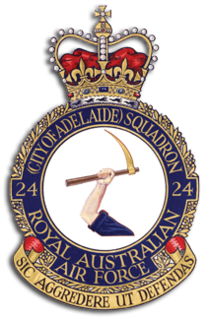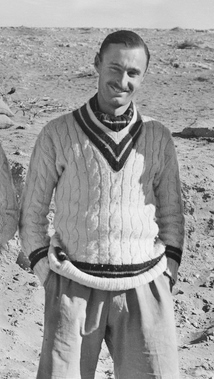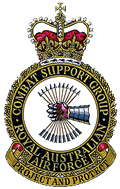The Airfield Defence Guard (ADG) mustering of the Royal Australian Air Force (RAAF) performs specialist ground defence tasks to protect air power assets from hostile ground action. The mustering is composed of non-commissioned members, commonly called 'ADGies,' most of whom are employed within a Security Forces (SECFOR) Squadron (SQN). Their primary role is the protection of RAAF equipment, personnel, assets and facilities during operations. While ADGs train to counter special forces as the primary ground threat to the projection of air power, ADGs are themselves conventional forces. Other duties include training RAAF personnel in weapon handling and basic ground defence tactics.

No. 30 Squadron is a squadron of the Royal Australian Air Force (RAAF). Raised in 1942 as a long-range fighter unit, the squadron saw action in the Second World War, serving in the South West Pacific Area against the Japanese and operating mainly in the ground attack and anti-shipping roles from bases in New Guinea and the Netherlands East Indies. After the war, the squadron was disbanded, however, it was re-raised a short time later as a unit of the part-time Citizen Air Force, operating in the target towing and air defence role in New South Wales. In 1960s the squadron ceased flying aircraft and operated surface-to-air missiles, providing for the defence of Sydney and Darwin before disbanding in 1968. The squadron was re-raised again in 2010 and since then it has served as an airbase support squadron located at RAAF Base East Sale.
The Royal Australian Air Force currently maintains three Bare Bases in remote areas of Northern Australia. These bases were developed in the 1980s and 1990s in line with the Defence of Australia Policy in order to enhance the RAAF's ability to conduct combat operations from the Australian mainland. As front line bases, the bare bases are well provisioned with bunkers and other defensive facilities and have the capability to support the RAAF's combat aircraft during wartime.

No. 13 Squadron is a Royal Australian Air Force (RAAF) squadron. The squadron saw combat during World War II as a bomber and maritime patrol squadron and is currently active as a mixed regular and reserve RAAF unit located in Darwin, fulfilling both operational support and training duties.

No. 24 Squadron is a Royal Australian Air Force squadron. The squadron was formed in 1940 and saw action as a bomber squadron during World War II serving in the Pacific theatre against the Japanese, and undertaking operations during the Battle of Rabaul, and the New Guinea, New Britain and Borneo campaigns. The squadron was disbanded in 1946 following the conclusion of hostilities, but was re-formed in 1951. From then until 2010 the squadron was an RAAF Reserve squadron located near Adelaide, South Australia; for part of this time, until 1960, the squadron continued to perform flying duties, before converting to a ground support role. In 2010, the squadron combined with Combat Support Unit Edinburgh to become a Permanent Air Force unit and it currently forms part of No. 96 Wing, Combat Support Group.

The Royal Australian Air Force's Air Combat Group (ACG) is the group which administers the RAAF's fighter and bomber aircraft. ACG was formed on 7 February 2002 by merging the RAAF's Tactical Fighter Group and Strike Reconnaissance Group in an attempt to improve the speed with which the RAAF can deploy its combat aircraft. The current commander of ACG is Air Commodore Anthony Grady.
No 395 Expeditionary Combat Support Wing is a ground support wing of the Royal Australian Air Force (RAAF). Part of the Combat Support Group, it is responsible for the provision of combat and base support services, including command and control of airbases and airspace, force protection, communications and logistics. Consisting of 11 sub units, it is one of the largest RAAF units and is made up of one Combat Communications Squadron, two Expeditionary Combat Support Squadrons, two Airfield Defence Squadrons and seven Combat Support Units which are based at various locations around Australia.

No. 396 Expeditionary Combat Support Wing is a ground support wing of the Royal Australian Air Force (RAAF). Part of the Combat Support Group, it is responsible for the provision of combat and base support services and maintains the RAAF's "bare bases" at Weipa, Exmouth and Derby in the northern part of Australia's airspace. The wing consists of three expeditionary combat support squadrons, one combat support squadron, an operations support squadron, a combat logistics squadron and two support units, which are located at various bases all around Australia, and in Malaysia at RMAF Butterworth.
No. 1 Airfield Operations Support Squadron (1AOSS) is Headquartered at RAAF Base Townsville. The squadron has detachments at each of the major RAAF Bases around Australia. It is responsible for providing fixed-base and expeditionary Air Movements support, Explosive Ordnance Disposal (EOD) functions, Airfield Engineering, including vertical and horizontal construction capabilities, and 3rd line logistics support to the RAAF's Expeditionary Combat Support Squadrons.
The No. 382 Expeditionary Combat Support Squadron RAAF (382ECSS) was a Royal Australian Air Force combat support squadron established in 1998, and based at the RAAF Base Amberley, southwest of Ipswich, Queensland. It is a fully deployable unit which provides operational support to a forward operating base. Although its usual role was to supplement base services at RAAF Base Amberley, it had the capability to deploy to bare base and provide all the services to make it a fully operational base.
381ECSS is an expeditionary combat support squadron of the RAAF formed at RAAF Williamtown, NSW in May 1998. It is a fully deployable airbase operations unit that provides airbase-specific operations support and common 'close' combat support functions to one or more collocated flying units at a forward operating base. Effectively an ECSS runs the base support to ensure lodger flying units are able to concentrate on the projection of the required air power to support directed RAAF missions.
No. 322 Expeditionary Combat Support Squadron (322ECSS) is a Royal Australian Air Force (RAAF) ground support squadron based at RAAF Base Tindal near Katherine, Northern Territory. In addition to providing support services at RAAF Tindal, it also has responsibilities for the three RAAF bare bases: RAAF Scherger near Weipa, Queensland, RAAF Curtin near Derby, Western Australia and RAAF Learmonth near Exmouth, Western Australia; and the Delamere Air Weapons Range.
No. 23 Squadron of the Royal Australian Air Force (RAAF) is a non-flying base operations and training squadron headquartered at RAAF Base Amberley near Brisbane, Queensland. The squadron was formed in 1937 and saw action against the Japanese during World War II as a bomber squadron. Operating from Archerfield during the early stages of the war, the squadron undertook maritime patrols off Australia's east coast before converting to a dive-bomber role and taking part in the New Guinea campaign. Later in the war, the squadron converted to Liberator heavy bombers and flew missions against Japanese targets in the Netherlands East Indies. After the war, No. 23 Squadron was used to reform No. 6 Squadron and was then re-raised as a Citizens Air Force unit based in Brisbane. Until 1960, the squadron flew jet fighter aircraft before converting to a ground support role and now forms part of the RAAF's Combat Support Group.
No. 27 Squadron RAAF is a Royal Australian Air Force (RAAF) reserve and ground support squadron located at RAAF Base Townsville, Queensland. The squadron was formed on 1 July 1981 to recruit and train RAAF reservists in the Townsville area and in July 2010 took on the additional role of providing support services to RAAF Base Townsville.

Air Commodore Gordon Henry Steege, DSO, DFC was a senior officer in the Royal Australian Air Force (RAAF). He became a fighter ace in World War II, credited with eight aerial victories. Joining the RAAF in July 1937, Steege first saw action with No. 3 Squadron in the Middle East, where he was awarded the Distinguished Flying Cross after shooting down three German aircraft in a single sortie. He rose to command No. 450 Squadron in the Desert Air Force, before being posted to the South West Pacific, where he led Nos. 73 and 81 Wings. He earned the Distinguished Service Order for his "outstanding leadership", and finished the war a temporary group captain.

RAAF Base Amberley is a Royal Australian Air Force (RAAF) military airbase located 8 km (5.0 mi) southwest of Ipswich, Queensland in Australia and 50 km (31 mi) southwest of Brisbane. It is currently home to No. 1 Squadron and No. 6 Squadron, No. 33 Squadron and No. 36 Squadron. Amberley is also home to Army units making up the 9th Force Support Battalion. Located on 1,600 hectares, RAAF Amberley is the largest operational base in the RAAF, employing over 5,000 uniformed and civilian personnel. There are a variety of other formations on the base such as training colleges and maintenance areas. Amberley's largest squadron in terms of personnel is No. 382 Expeditionary Combat Support Squadron RAAF (ECSS) providing both garrison and deployed combat support. Amberley was one of only two airfields in Australia that were listed as a Transoceanic Abort (TOA) landing site for the Space Shuttle. Amberley is currently undergoing a A$64 million dollar re-development program. The RAAF has plans to have Amberley operating as its "superbase" with flights of F/A-18F Super Hornets, F-35 Lightning II, KC-30A, C-17 Globemaster. No. 35 Squadron is planned to move to the base from RAAF Base Richmond after it is fully equipped with the C-27J.
No. 321 Expeditionary Combat Support Squadron (322ECSS) was a Royal Australian Air Force (RAAF) ground support squadron based at RAAF Base Darwin near Darwin, Northern Territory.











